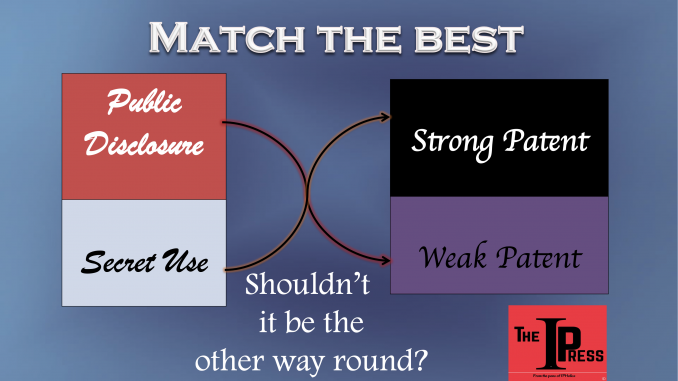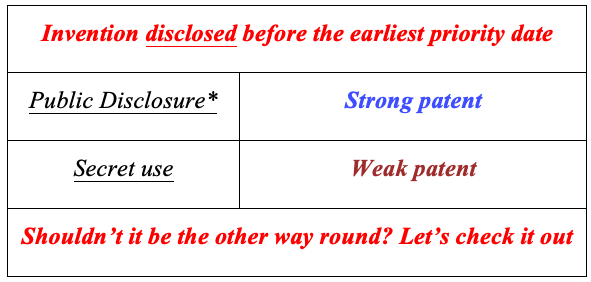

Secret use of an invention before filing a patent application could amount to public use and such public use of the invention would be beyond the exceptions of anticipation under the Indian patent law. The strength of a patent would accordingly be affected. Below is an explanation of this prologue.
The Indian Patents Act, 1970 under Section 25 (5) prohibits the Controller in patent opposition proceedings from taking into account any personal document or secret trial or secret use of inventions. The same statute under Section 64(1)(l) however, allows the Court to take into account the secret use of inventions for revocation proceedings. The discrimination between the grounds of opposition and revocation proceedings has not been explained in the Indian patent law or interpreted by Indian courts but the UK courts have explained it, as follows:
“Apparently the reason for excluding secret user as a ground of objection while making it a ground of revocation was that Parliament did not wish the administrative authority granting patents ‘to have to deal with complicated questions of secrecy”
The aforesaid reasons appear very convincing and logical, as the patent offices would lack resources, like a legal institution, to decide these matters involving the law of evidence and law of contracts. Hence, the Indian patent law rightly followed suit. The revocation of a patent on the ground of ‘secret use’ is essentially to prohibit the inventors from having a commercial advantage. The secret use of the invention would give rise to possibilities of malicious conduct by the patentee like stockpiling, an attempt to extend the term of monopoly rights, etc.
Regarding “secret use” of inventions in the revocation proceedings, according to one of the essentials under patent law, inventions should not be disclosed to the public before the earliest priority date of patent applications – in layman words – before filing (earliest) patent applications. Of course, given the exceptions to anticipation under patent law, public disclosure of inventions is allowed before filing patent applications [check section 29 to 34 of the Indian patents act, 1970], however, the notion of ‘secret use’ of inventions is something beyond such exceptions.
Before filing the patent application there are usually two circumstances that result in ‘secret use’ of an invention: (i) During planning and marketing phase – commercialization, the invention is disclosed to investors in the absence of non-disclosure agreement; (ii) the use of the invention ambiguously in a machine, e.g. use of a product in a car’s engine is not visible to the public. The “secret use” of the inventions in the above two conditions would be treated as the public use and for such use, the exceptions to anticipation would not be applicable.
(i) ‘Secret use’ of the invention for commercialization
Zuko Pty Ltd. v. Old Digger Pty Ltd. [(2001) 52 IPR 75] was a case in which the Australian court dealt with a situation where a patentee manufactured 15-20 hammers for his potential customer before filing a patent application. Taking advantage of this shortcoming, the alleged infringer filed a counter-claim proceeding to revoke the patent, as the invention was publicly used in a commercial activity before the priority date, and the same was kept secret. Interestingly, the same customer owned the site on which the patentee conducted trials and experiments of his invention. The customer noticed those hammers during the trial phase and proposed the patentee to sell these to him. The patentee accordingly manufactured the hammers but never sold them before filing the patent application. The alleged infringer disputed this whole situation and claimed that the supposed ‘secret use’ was of commercial nature, and hence part of the public domain.
The court however decided the case in favor of the patentee owing to the fact that “use” of the invention, before the priority date, was confidential in nature, as the patentee did not intend to sell it.
However, the discussed case sheds light on a question whether the patentee’s act of producing hammers before the earliest priority date would amount to an extension of the term of patents. Upon analyzing the patentee’s conduct, I believe that, by secretly using the invention, he tried to play with the Tick-Tock of the clock starting the 20 years term of patent rights. Hence, it causes de facto extension of the term of a patent.
Fomento Industrial SA v. Mentmore Manufacturing Co. Ltd
Meaning of the term “Use” should be construed with respect to inventions and not with respect to “articles” produced by those inventions
The act of making and using of the invention, before the priority date, might be only to ensure the immediate supply of the articles to the customers. However, such production would anyhow lead to stockpiling of the products, as it involves the right of “using”. Hence, probing the situation through the lens of “reverse test of infringement”, stockpiling is a prohibited act under Section 48 of the Indian patents act and it would have been considered infringement, if committed by some other person.
Hence, secret use of the invention without the non-disclosure agreement would be deemed public use, beyond the exceptions of anticipations. Such use of the invention might not give the immediate financial advantage to the patentee but it would indirectly set him a stage for action leading to the extension of the term of patents.
(ii) When the invention is ambiguously used in a machine, as not visible to the public
Lately, I have come across the US case of Egbert v. Lippmann, 104 U.S. 333 (1881), which is apt to elaborate this issue–use of the invention when not visible to the public. In this case, two women complained of their broken corset-steels, which encouraged the inventor to produce the improved pair of corset-steels. For trial and experimentation of the invention, he gifted it to his girlfriend and she wore it for a longer time period. Since a corset-steel is worn inside a dress, the invention was not visible to the public and hence, one may say that there is no public disclosure or public use of the invention. Almost after ten years, the lady, his girlfriend, applied for a patent over the corset steel, which was rejected by USPTO. The rejection however was not only due to the failure to apply within the grace period (2 years at that time) given under the exceptions to anticipation but the act of gifting the invention to his girlfriend, without any confidentiality agreement, was considered the public use of the invention. The patent application might have been allowed if the relationship between the inventor and the lady was formal (husband & wife), as there exists a possibility of implicit confidentiality (if not explicit). But the informal relationship does not create obligations of confidentiality on partners and the invention could have been disclosed to other people.
Below is the take away from the above-discussed cases:
Filing a patent application after the grace period: Delay in filing a patent application, even beyond the grace period (mostly 12 months), for conducting public trial and experimentation might be allowed if the nature of inventions requires public use and the delay was to conclude the research. However, inventions disclosed secretly before the earliest priority date without a non-disclosure agreement would be considered as public use.
Use by one person – is it enough to destroy novelty? Use of inventions even by a single person, before the priority date, would be considered public use unless the use is covered under a non-disclosure agreement.
In view of the above, one can conclude that the secret use of inventions, even when the invention is not visible, would still be considered public use. Similarly, during the course of production of the article on which the invention is applied, the disclosure of the invention made to even a single person would amount to public use, unless there is a confidential agreement. However, the application of the confidential agreement would still be limited to the grace period provided under the exceptions of anticipation under the patent laws.
Hence, what constitutes a “secret use” of an invention is challengingly subjective in light of the different jurisprudence developed by the US, UK and Australian courts and currently unexplainable in India, as courts have never had an occasion to hear the same. Nevertheless, whenever the Indian courts would be dealing with such issues in future, it will be a demanding task to decide over the patent invalidity on the ground of a colossally broad term “secret use” in light of the circumstantial evidence. The aforesaid cases might then be helpful to draw an analogy on what kind of secret use would be considered the public use in India.
Well Drafted.!! 👍 8-July-2020.
1) *___Preference___* Public use/Public display/Public working with *NON DISCLOSURE AGREEMENT & FOR NON COMMERCIAL USE* is the Key before priority date of the application.
*My View-*
2) Secret Use of the invention is NOT recommended.! Since it does have back door benefits to the Patent Applicant.! And these being cited OR recognized in prosecution OR Revocation proceedings.!